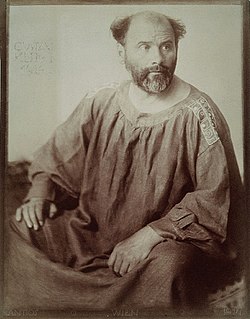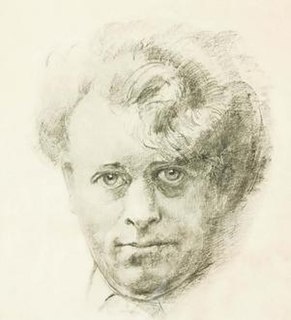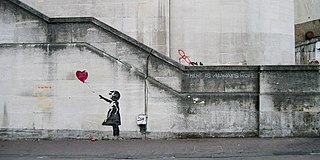Related Research Articles

Edvard Munch was a Norwegian painter. His best known work, The Scream, has become one of the most iconic images of world art.

Gustav Klimt was an Austrian symbolist painter and one of the most prominent members of the Vienna Secession movement. Klimt is noted for his paintings, murals, sketches, and other objets d'art. Klimt's primary subject was the female body, and his works are marked by a frank eroticism. In addition to his figurative works, which include allegories and portraits, he painted landscapes. Among the artists of the Vienna Secession, Klimt was the most influenced by Japanese art and its methods.

A mural is any piece of artwork painted or applied directly on a wall, ceiling or other permanent surfaces. A distinguishing characteristic of mural painting is that the architectural elements of the given space are harmoniously incorporated into the picture.

The Mona Lisa is a half-length portrait painting by the Italian artist Leonardo da Vinci. It is considered an archetypal masterpiece of the Italian Renaissance, and has been described as "the best known, the most visited, the most written about, the most sung about, the most parodied work of art in the world." The painting's novel qualities include the subject's expression, which is frequently described as enigmatic, the monumentality of the composition, the subtle modelling of forms, and the atmospheric illusionism.

Mark Rothko, born Markus Yakovlevich Rothkowitz, was an American painter of Lithuanian Jewish descent. Although Rothko himself refused to adhere to any art movement, he is generally identified as an abstract expressionist.

Banksy is an anonymous England-based street artist, vandal, political activist, and film director, active since the 1990s. His satirical street art and subversive epigrams combine dark humour with graffiti executed in a distinctive stenciling technique. His works of political and social commentary have been featured on streets, walls, and bridges of cities throughout the world. Banksy's work grew out of the Bristol underground scene, which involved collaborations between artists and musicians. Banksy says that he was inspired by 3D, a graffiti artist and founding member of the musical group Massive Attack.

Jack Vettriano,, is a Scottish painter. His 1992 painting The Singing Butler became a best-selling image in Britain.

Vladimir Grigoryevich Tretchikoff was an artist whose painting Chinese Girl, popularly known as The Green Lady, is one of the best-selling art prints of the twentieth century.

Chinese Girl is a 1952 painting by Vladimir Tretchikoff. Mass-produced prints of the work in subsequent years were among the best-selling of the twentieth century. The painting is of a Chinese young woman and is best known for the unusual skin tone used for her face—a blue-green colour, which gives the painting its popular name The Green Lady. Though Tretchikoff maintained that the first version of this painting had been destroyed in Cape Town and he painted a new version during his 1953 tour of the USA, researchers have found no proof of this claim.

Since the 1980s, the area surrounding the inner-Sydney suburb of Newtown, New South Wales (NSW), Australia—including the suburbs of Newtown, Enmore, Erskineville, Camperdown and St Peters—has been known for its wide range of prominent graffiti and street art on walls. The public visual art in the Newtown area consists of a variety of styles and methods of execution, including large-scale painted murals, hand-painted political slogans, hand-painted figurative designs, spray painted semi-abstract designs "tags"), and other stylistic developments such as stencil art and street poster art, "Yarn bombing", and sculptural items cast from plaster and other materials.

Stephen J. Powers is a contemporary artist and muralist currently living and working in New York City. He is also known by the name ESPO.
"Bad" Painting is the name given to a trend in American figurative painting in the 1970s by critic and curator, Marcia Tucker (1940–2006). She curated an exhibition of the same name, featuring the work of fourteen artists, most unknown in New York at the time, at the New Museum of Contemporary Art, New York. The exhibition ran from January 14 to February 28, 1978. "Bad" Painting was not a demonstration of technical incompetence, poor artistic judgement, amateur or outsider dabbling, the term is commonly used for these. For Tucker, it denoted a more focused or deliberate disrespect for recent styles. The press release for the exhibition summarised "Bad" Painting as "...an ironic title for 'good painting', which is characterized by deformation of the figure, a mixture of art-historical and non-art resources, and fantastic and irreverent content. In its disregard for accurate representation and its rejection of conventional attitudes about art, 'bad' painting is at once funny and moving, and often scandalous in its scorn for the standards of good taste." Her use of quotation marks around "Bad" points to this special meaning. "Bad" here, is thus a term of approval for the more eccentric and amusing variations on certain accepted styles, at that time.

Lady Writing a Letter with her Maid is a painting by the Dutch artist Johannes Vermeer, completed in 1670–1671 and held in the National Gallery of Ireland. The work shows a middle-class woman attended by a housemaid who is presumably acting as messenger and go-between for the lady and her lover. The work is seen as a bridge between the quiet restraint and self-containment of Vermeer's work of the 1660s and his relatively cooler work of the 1670s. It may have been partly inspired by Ter Borch's painting Woman Sealing a Letter. The painting's canvas was almost certainly cut from the same bolt used for Woman with a Lute.

The Museum of Old and New Art (MONA) is an art museum located within the Moorilla winery on the Berriedale peninsula in Hobart, Tasmania, Australia. It is the largest privately funded museum in the Southern Hemisphere. MONA houses ancient, modern and contemporary art from the David Walsh collection. Noted for its central themes of sex and death, the museum has been described by Walsh as a "subversive adult Disneyland".

Caroline Shotton is a British commercial artist who frequently incorporates cows into her artwork. Caroline gained recognition for her 2007 Great Moosters series, re-imagining famous paintings using the cow motif.

Faith47 / Faith XLVII is a South African interdisciplinary artist who has held solo exhibitions in Miami (2018), New York City (2015), London (2014) and Johannesburg (2012). As both a notable South African and woman street artist, Faith speaks to issues of human rights, spiritual endurance and social issues.

Self-Portrait with Halo and Snake, also known as Self-Portrait, is an 1889 oil on wood painting by French artist Paul Gauguin, which represents his late Brittany period in the fishing village of Le Pouldu in northwestern France. No longer comfortable with Pont-Aven, Gauguin moved on to Le Pouldu with his friend and student Meijer de Haan and a small group of artists. He stayed for several months in the autumn of 1889 and the summer of 1890, where the group spent their time decorating the interior of Marie Henry's inn with every major type of art work. Gauguin painted his Self-Portrait in the dining room with its companion piece, Portrait of Jacob Meyer de Haan (1889).

Woodstock Mural is a mural designed by artist Mike Lawrence, painted on the west side of the New Seasons Market store in the Woodstock neighborhood of Portland, Oregon, in the United States. The painting has three sections, each representing a theme: commerce, education, and the outdoors. It depicts figures adorned with symbolism related to characters in Greek mythology, including Hermes, Athena, and Demeter, along with local businesses and local landmarks such as the neighborhood farmers' market, Grand Central Bakery, Portland Fish Market, Woodstock Park, and the Woodstock Library.

Girl with Balloon is a 2002-started London series of stencil murals by the graffiti artist Banksy, depicting a young girl with her hand extended toward a red heart-shaped balloon carried away by the wind. The first work was on Waterloo Bridge, and other murals were around London, though none remain there. Banksy has several times used variants of this design to support social campaigns: in 2005 about the West Bank barrier, in 2014 about the Syrian refugee crisis, and also about the 2017 UK election. A 2017 Samsung poll ranked Girl with Balloon as the United Kingdom's number one favourite artwork.

Love is in the Bin is a 2018 art intervention by Banksy at Sotheby's London, with an unexpected self-destruction of his 2006 painting of Girl with Balloon immediately after it was sold at auction for a record £1,042,000. According to Sotheby's, it is "the first artwork in history to have been created live during an auction." The painting has been on permanent loan to the Staatsgalerie Stuttgart since March 2019.
References
- ↑ "It isn't bad taste. It's a pivotal work of transgressive irony; Michael Bracewell on an exhibition which challenges all your values". The Guardian . 13 November 1999.
- 1 2 Allen, Jeremy (November 27, 2014). "Swan Songs: Baxter Dury Interviewed". The Quietus.
- ↑ "Coming soon to a wall near you". Evening Standard. November 8, 2000.
- ↑ "stephen pearson". Thecontainergallery.co.uk. Retrieved 2017-05-25.
- ↑ "Obituary". Art Business News. 30 (6): 14. June 2003.
- ↑ McMillan, Michael (2009). The Front Room: Migrant Aesthetics in the Home.
- ↑ Whitford, Frank (October 11, 1992). "Sunday At home with the master". The Sunday Times .
- ↑ "HOMESTYLE: HOW'S IT HANGIN'?; THESE DAYS WE CHANGE THE ART ON OUR WALLS AS FREQUENTLY AS OUR.". Sunday Mirror . 28 January 2001.
You can still buy it and in Scandinavia it's still on their bestseller list. When it was first available in 1972, its popularity was due to its encapsulation of the dawning of the Age of Aquarius - freedom. Plus it's a bit rude.
- ↑ Sadiq, Rashida (2011). "Review: Saddam's Babylon". Super Massive Black Hole Magazine (8).[ better source needed ]
- ↑ http://www.beesofrita.com/audiovisual-self-portrait/.Missing or empty
|title=(help) - ↑ "Weekend: WONDERWALLS: There was the tennis girl, that man and baby, the icy, airbrushed women with electric blue eye shadow and glossy red lips. Think of the pictures that bedecked the bedrooms of teenagers 20 years ago and one name springs to mind: Athena. As the 1980s enjoy a revival, Lindsay Baker looks back at the poster company that became a phenomenon". The Guardian. November 10, 2001.
- ↑ "Coming soon to a wall near you; Charles Saatchi reckons Wayne Hemingway's collection of kitsch art is 'the right stuff'. NICK CURTIS says the time is ripe for the reinvention of tat". Evening Standard . November 8, 2000.
- ↑ Sandbrook, Dominic (2012). Seasons in the Sun: The Battle for Britain, 1974-1979. Penguin. ISBN 9781846140327.
- ↑ Middleton, Francesca (2014). "A Queen of Hearts and a White Rabbit: Storytelling Traditions, Lacunae and Otherness in Neil Jordan's Mona Lisa (1986)". Studies in European Cinema. 11 (3).